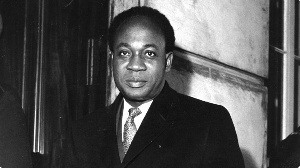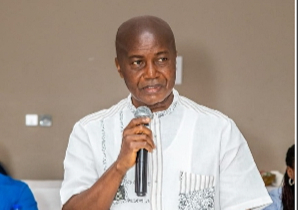- Home - News
- TWI News | TV
- Polls
- Year In Review
- News Archive
- Crime & Punishment
- Politics
- Regional
- Editorial
- Health
- Ghanaians Abroad
- Tabloid
- Africa
- Religion
- Election 2020
- Coronavirus
- News Videos | TV
- Photo Archives
- News Headlines
- Press Release
Opinions of Saturday, 23 September 2017
Columnist: Kofi Ellison
Who 'founded' Ghana?
Perhaps, for those Ghanaians of the Gold Coast mentality tearing themselves up, intellectually, and otherwise, asserting and affirming who FOUNDED Ghana, they should cast their minds back and look at who really ‘discovered’ the process that eventually led to the establishment of the Gold Coast Colony (the present day Western; Central; Eastern; Greater Accra Regions; and Anlo area in the Volta Region).
The first book that I recall owning was called, in Twi “Kan me hw?.” The two books written in English, that together with the aforementioned book in Twi, that my grandmother (Onyame Nhyira wo, Nana Abena Bio) bought for me were... W.E. Ward’s “History of The Gold Coast and Ashanti;” and a book of “FACTS,” called “Facts to Remember.” I was in Primary School, then. Facts to Remember was a treasured book of ‘facts” on Gold Coast, Asante, and British, and indeed world history. And, one of the pertinent questions in that book was:
“Who discovered the Gold Coast (Ghana). The answer was “Don Diego d’Azambuja of Portugal!” This answer was accepted as FACT, until the eminent historian, Professor Adu Boahen questioned that.. in the 1960’s when he wrote his magisterial text book “Topics in West African History,” and serialized it in a presentation on Ghana TV.
Spoiler alert: Adu Boahen queried, How could Azambuja discover the Gold Coast, when he acknowledged that he met “Chief Caminah Anssah” and his people, when he arrived. They were ALREADY on the land that Azambuja called “Da Mina?”
Until 1471, Europeans had not sailed beyond Cape Bojador, off the northern coast of Western Sahara because of a prevailing fear that beyond Bojador, the sea was so hot it would burn ships. That received wisdom was shattered in 1871, when the Portuguese Don Diego d’Azambuja, sailed a ship to the coast of what became Gold Coast, and then Ghana. He named the place Da Mina or The Mine because gold was being sold in abundance. He met among others “Housas” or Hausas; Indians; Arabs; trading with ‘natives’ who bought ‘imported’ goods from the foreign traders with gold.
As Adu Boahen wrote, Azambuja just arrived; and met PEOPLE. He did not discover anyone.
Azambuja returned to Lisbon and told the King of Portugal of his find. On January 19, 1482, Azambuja returned to Da Mina with 600 men and materials to establish a permanent settlement. He negotiated and paid for a piece of land with the Chief of the town of Edina, whom he called Caminnah Anssah/Kwamena Ansah. In 20 days he had completed the Castle or Fort which he named São Jorge da Mina…..named after Saint George, the Catholic Patron Saint of Portugal/Lisbon. Da Mina later became EL MINA and finally ELMINA. The guns mounted at the Castle were turned in the direction of the Atlantic Ocean to warn other Europeans who may venture and try to attack.
The town of Elmina was elevated to a city annex (i.e. an integral part of Portugal) of Lisbon and granted political freedom by King Jorge II of Portugal in 1486. The original (Portuguese) Elmina Township, which was opposite the castle, was then fenced to show that status. The indigenous town called Edina was separate, and ruled by King Kwabena Kagya Ansa, whose name has been corrupted following European rendition as Kwamina Kweigyah Ansah.
A point about “Patron Saints.” Before the advent of Christianity, most towns in Europe had ‘Gods’ associated with towns, who it was believed protected the town/village/important or families from evil. With the introduction of Christianity, the people needed that close association and protection. So, the Pope decided to consecrate ‘deceased’ Catholics as "Saints.” These "Saints" then served as replacement for those ‘Gods.’ I believe, St. Peter is the Patron Saint of Rome.
We had a simlar belief system in ASANTE. Every Asante town had a “God” who reportedly protected that town; and, families also had “Gods’ for similar purpose. For example, my hometown has “KOBIRI,” as our GOD interceding on our behalf. There is still a VIRGIN forest that my ancestors dedicated for KOBIRI called “KOBIRI KWAE” (KOBIRI’s FOREST) still in existence, still NEVER been disturbed, though reportedly now under GALAMSAYERS threat. My family GOD is ‘AKROMA’…the EAGLE protecting me/us, as my maternal grandmother told me. I do not eat any bird that flies, as a recognition of that.. BTW, Akok? and Akonf?m do not fly, necessarily! In the days of migration, families left, and traveled with their Gods who were then ‘planted’ in the new settlement. Ours, came from Abankesieso, Dankyira; to Oda (Akyem Kotoku), to SANTASE (near Kumase), to Tweneduase (Santase Trede road), and beyond. “Nananom, nsa,’ nie for retelling the family story here….just for education and elucidation. Onyame dada no ara, na y? som no.
Among those on board the Azambuja’s 1482 trip to Da Mina was an Italian guy called Cristoforo Colombo, anglicized as Christopher Columbus. Now, when I Asantenize “Mall” as “Morr”, you call me ‘uneducated.' TWEAA KAI. Dare call the English, that?
Azambuja’s ‘discovery’ was earth-shattering, to say the least. It led to the decline and total stop of the TRANS SAHARA TRADE ROUTE by which West Africans conducted trade with North Africa and the outside world, across the Sahara Desert, since the beginning of the world. It shifted trade from land to sea. It led to the rounding of South Africa, and the ‘discovery’ of the sea route to India and Asia…including Japan and China.
It led to Colombus voyages…trying to get to India…he got lost and landed in what became Jamaica; Cuba; and Haiti. Colombus thought he had reached INDIA so he called the people he met INDIANS!, and the land, The West Indies; subsequently, part of the ‘discovery' of the NEW WORLD with consequential consequences. And Azambuja’s trip and settlement at Elmina Castle, directly led to the Trans Atlantic Slave Trade....and the "forced migration," of MILLIONS of Africans. Then, led to the colonization of the land that became the Gold Coast.
Now known as ELMINA CASTLE, it is the oldest European building outside of Europe, in the world. After defeating Portugal in Elmina, the Dutch (Holland) took over the Castle. However, in the 17th century, the King of Dankyira… Boa Ampnsem controlled that sea coast, and demanded the Dutch to pay him ground rent for the Elmina Castle, which the Dutch did.
In 1701, ASANTE defeated Dankyira, and the payment of the ground rent was taken over by Asante. The Dutch paid the rent to Otumfuo Asantehene until 1872 when the Dutch sold the Elmina Castle to the British. The British stopped the payment when it defeated Asante in the SAGRENTI WAR of 1873-1874. When Asantehene Prempeh I surrendered to the British (without a fight) in 1896), he was taken to Cape Coast Castle, but was later transferred to the Elmina Castle.
The room Nana Prempeh lived in was/is called “PREMPEH ROOM” at the Elmina Castle.
In 1957, the government of the independent country named GHANA took over the Elmina Castle, as it it did the 33 European Castles/Forts built along the coast to facilitate European trade.
Ponder over this...











